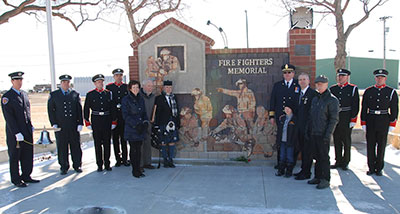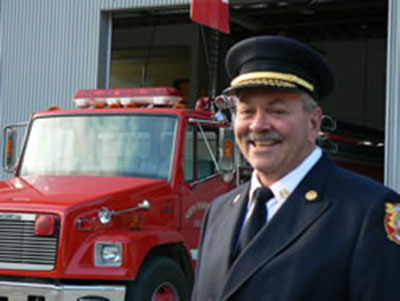
Features
Hot topics
Incident reports
Honouring a century-old sacrifice
The date is March 19, 2013, the temperature is -8 C and the sky is bright blue in Medicine Hat, Alta.
September 27, 2013
By Charles Boyte
The date is March 19, 2013, the temperature is -8 C and the sky is bright blue in Medicine Hat, Alta. The unique sound of a highland piper playing “Flowers of the Forest” into the clear crisp air can be heard for at least a kilometre in all directions.
 |
|
| Members of the Medicine Hat Fire Department in Alberta, the Honour Guard and the family of William Stewart stand by a local firefighter memorial. The names of the three firefighters who died fighting the 1913 blaze were added to a plaque on the memorial. Photo courtesy the Foote family
|
Coaxed gently by a father’s hand, a young boy steps forward. Cradled in his small hands is a homemade wreath lovingly crafted from West Coast salal and cedar boughs. Young Thomas gently leans forward and lays the wreath at the base of the weathered headstone of his great, great grandfather. The headstone reads: “William Stewart, Died March 19, 1913, Age 25 years 7 months.”
***
In the early 1900s, the allure of cheap natural gas had brought industry to Medicine Hat and the city was burgeoning. Natural gas was so plentiful that almost everyone who owned a house and property had drilled a gas well in the backyard. While this led to fortunes for many, it did not come without some cost. Pockets of gas regularly escaped the crude wells and piping, caught fire and burned down homes and businesses.
It was not uncommon in those days for a business owner to go to work, light the gas lamp and blow up the building. As the number of fires increased, the city built and equipped two fire stations for the town of 10,000. Steam pumps and ladder wagons were pulled to the fires by teams of sturdy horses. As was the case in many small towns during that era, the firefighters were mostly community volunteers who would run to the station, hitch up the horses and bravely head out to tackle any fire that started.
The large three-storey brick building on Main Street had housed a patchwork of enterprises; none, however, had found success within its walls. The building was constructed as a woolen mill. That business had failed twice before a promoter named Malcolm proposed to turn it into a huge beef cannery. Malcolm was doomed to failure through his dubious manipulations and the company was reorganized twice more before becoming the Western Canada Cold Storage and Meat Packing Plant. This new company was solidly financed and the new machinery at Malcolm Canneries Number Five stood ready to go. Soon the workers would be hired, the power switched back on, and the whirr of belt-driven machines would bring life to the factory.
The company employed a caretaker by the name of McQueen. On March 19, 1913, shortly before 4:30 p.m., McQueen noticed a flash of flame run along the exterior wall and then disappear below the floor. At exactly 4:40, McQueen saw smoke and telephoned an alarm to the fire station.
William Stewart was an interior decorator who had moved to Medicine Hat some seven years earlier. He had a good reputation in town, had built a house for his wife Ima, 23, daughter Margaret (Margie), two years old, and a newborn son, Herbert William (Bill), who was barely two weeks old. William was a responsible, fit young man and had just recently joined the volunteer fire department. His regimental number was 97 and he proudly wore it in service to his community.
It was Wednesday afternoon and the fire station bells sounded to summon the volunteer firefighters. William dropped what he was doing and ran out the door just as he had done so many times before. He arrived at the station, donned his gear and headed off with the first team of horses as they dragged the heavy brass fire pump off to the fire at Malcolm Canneries Number Five.
The three-storey building stood ominously quiet and dark when the firefighters arrived. That meant they would have to enter the building and seek out the fire, before it got hold of the building and spread to the rest of the town. A crowd gathered in the street as the brave firefighters headed inside with axes and hoses in hand. They pushed inward until a small wisp of smoke could be seen seeping out from the floorboards. The smoke was just as McQueen had described and clearly a clue to the hidden fire beneath.
Firefighter Ringler quickly chopped a hole through the floor to get at the fire below. On the final swing of his axe, there was a rush of deadly gas. Fire hoses quickly pushed it back in the hole but it was too late to prevent the explosion that followed. Ringler was blown toward the door by the massive blast but miraculously escaped uninjured. Several other firefighters were blown clear of the building, including Lt. McLeod, who had no recollection how he and the others had escaped or survived. Capt. Buchanan was tossed more than 60 feet by the blast but his partner, John Brier, was killed where he stood. As the building collapsed, many of the firefighters were narrowly missed by the heavy walls and were lucky to survive. William Stewart and Reginald Rimmer, however, were killed when a brick archway
collapsed inside.
The blast launched more than 25,000 square feet of roof three feet into the air, caused the building to fall, and hurled thousands of red bricks into the street. All that was left of Malcolm Canneries Number Five were faint cries for help in the rubble that littered the street. Five people died that afternoon, including three firefighters and two bystanders: a visitor from Boston by the name of Charles Bohannan and a 12-year-old boy by the name of Harry Green. Ten people were critically injured and three dozen more were wounded by flying or falling debris. There was mayhem on Main Street, yet the firefighters still standing forged on to restore order and to tend to the injured and dying.
***
Pender Island’s volunteer firefighters had offered to stand by for fire or medical emergencies at the inaugural launch of the Hope Bay Boat Days and Music Festival. Hope Bay is a waterfront commercial centre located on Pender Island, which lies between Vancouver and Victoria. In 1998, the buildings at Hope Bay burned and collapsed to the ground. The rebuilding took years and the centre is finally getting back on its feet. The sound of bagpipes and drums echoed in Hope Bay and the sea beyond as the event was opened in regal tradition by the Pender Highlanders.
Sue Foote, a Pender Island resident and one of the pipers that day, approached me at the fire truck and began to tell me the most remarkable story of love, tragedy, support and honour. I was captivated by the pride and emotion displayed in her eyes as she recounted the amazing series of events that had occurred in March of this year. The connections that unfolded in her story moved me to the core.
The story began with Foote’s planning of a memorial trip to Medicine Hat. She would gather the family descendants in recognition of the untimely death 100 years earlier of her grandfather, William Stewart. Foote’s grandfather was of Scottish heritage and, like her ancestors before her, Foote had become a Highland piper. Foote could think of no greater honour than to play the pipes and wear the Stewart family plaid scarf at a memorial service in Medicine Hat to commemorate the 100th anniversary of her grandfather’s death.
Foote contacted the fire chief in Medicine Hat in the hope that a few firefighters might attend the memorial she had planned in her grandfather’s honour. Chief Brian Stauth said he would be honoured to accommodate her request on March 19, 2013, exactly 100 years from the date of her grandfather’s death.
That call completed Foote’s arrangements for the memorial service but she was worried about playing in the freezing temperatures the pipers would surely encounter in March. She contacted Malcolm Sissons, pipe sergeant of the South Alberta Pipes and Drums, based in Medicine Hat, who was pleased to coach her through the challenges of cold-weather piping. Their conversation turned to a heritage meeting at which Malcolm and another local resident, Jim Marshall, were present. It turns out that Jim and his wife Lorine now live in the home that Foote’s grandfather built in 1912, just before his death. In a wonderful gesture of welcome and care, the Marshalls offered a tour of the house and Jim’s studio. To top off the day, the whole family was invited for dinner in their old family home. The Marshalls are just the third owners of the house and had moved it to a new location in town. As they arrived at the house Foote was amazed when she saw the address. It was 97 – the regimental number her grandfather had worn so proudly as a volunteer firefighter.
The day of the ceremony, Foote and her family arrived to find 30-plus firefighters, an honour guard and a procession of fire trucks assembled to escort them to the cemetery. This gesture of respect was truly overwhelming and a stunning beginning to a truly amazing day. Foote’s grandson Thomas was invited to ride in the fire truck as it led the procession to the Hillside Cemetery. Thomas then laid the wreath crafted by his grandmother at the weathered marble headstone of his great, great grandfather William Stewart. Foote fulfilled her vision to play her pipes at the Hillside Cemetery in honour of her grandfather and while doing so honoured a second fallen firefighter, J.A. Brier, who was also buried there. Foote’s family – son Scott, his wife Olga and daughter Cori and grandson Thomas – stood by to pay their respects while husband John recited a memorial eulogy to celebrate her grandfather’s life.
Foote was also invited to play the pipes at the Old Medicine Hat Hillside Cemetery in honour of the third firefighter, Reginald Rimmer, who was killed that fateful day. Finally, the family attended a memorial service for all three firefighters. The service was held at the Medicine Hat Firefighter’s Memorial located at Medicine Hat Fire Station # 3. The memorial bears a plaque with Foote’s grandfather’s name and was designed and crafted by none other than James Marshall. Foote was presented a commemorative plaque in honour of her grandfather’s sacrifice.
March 19, 1913, was a tragic day that ends with a wonderful story of family survival, love, respect and honour. These brave souls – William Stewart, J.A. Brier
and Reginald Rimmer – made the ultimate sacrifice.

|
|
Charlie Boyte has been in the fire service for 27 years, including 12 years as the fire chief for Pender Island Fire Rescue in B.C. He holds a Level 3 fire investigation certificate from the Canadian Fire Investigation School and received his CFO professional designation from the Canadian Association of Fire Chiefs in 2010. In 2011, he was named Canadian Volunteer Fire Chief of the Year. Contact him at chief@penderfire.ca
Print this page